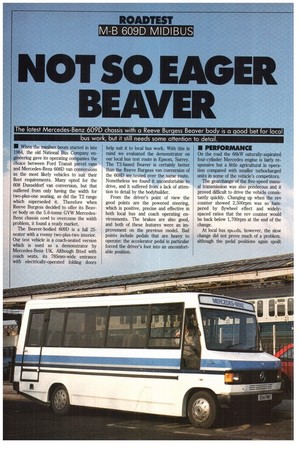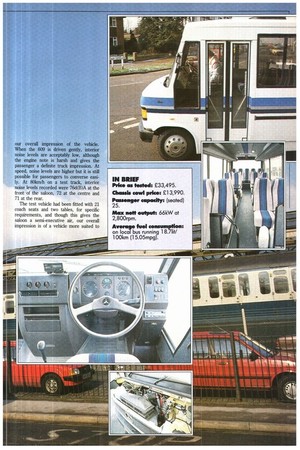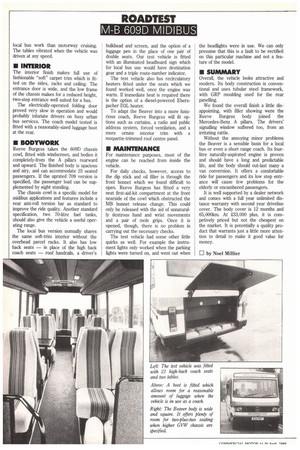NOT SO GER BEAVER
Page 64

Page 65

Page 66

If you've noticed an error in this article please click here to report it so we can fix it.
T e latest Mercedes-Benz 609D chassis with a Reeve Bur.ess Beaver bos is a .00d bet or local bus work but it still needs some attention to detail.
• When the minibus boom started in late 1984, the old National Bus Company engineering gave its operating companies the choice between Ford Transit parcel vans and Mercedes-Benz 608D van conversions as the most likely vehicles to suit their fleet requirements. Many opted for the 608 Dusseldorf van conversion, but that suffered from only having the width for two-plus-one seating, as did the T2 range which superseded it. Therefore when Reeve Burgess decided to offer its Beaver body on the 5.6-tonne GVW MercedesBenz chassis cowl to overcome the width problem, it found a ready market.
The Beaver-bodied 609D is a full 25seater with a roomy two-plus-two interior. Our test vehicle is a coach-seated version which is used as a demonstrator by Mercedes-Benz UK. Although fitted with coach seats, its 785mm-wide entrance with electrically-operated folding doors
help suit it to local bus work. With this in mind we evaluated the demonstrator on our local bus test route in Epsom, Surrey. The T2-based Beaver is certainly better than the Reeve Burgess van conversion of the 6081) we tested over the same route. Nonetheless we found it uncomfortable to drive, and it suffered from a lack of attention to detail by the bodybuilder.
From the driver's point of view the good points are the powered steering, which is positive, precise and effective in both local bus and coach operating environments. The brakes are also good, and both of these features were an improvement on the previous model. Bad points include pedals that are heavy to operate: the accelerator pedal in particular forced the driver's foot into an uncomfortable position.
• PERFORMANCE
On the road the 66kW naturally-aspirated four-cylinder Mercedes engine is fairly responsive but a little agricultural in operation compared with smaller turbocharged units in some of the vehicle's competitors.
The gearchange of the five-speed manual transmission was also ponderous and it proved difficult to drive the vehicle consistantly quickly. Changing up when the rev counter showed 2,500rpm was so hampered by flywheel effect and widelyspaced ratios that the rev counter would be back below 1,700rpm at the end of the change.
At local bus speeds, however, the slow change did not prove much of a problem, although the pedal positions again spoilt our overall impression of the vehicle. When the 609 is driven gently, interior noise levels are acceptably low, although the engine note is harsh and gives the passenger a definite truck impression. At speed, noise levels are higher but it is still possible for passengers to converse easily. At 80km/h on a test track, interior noise levels recorded were 76d(B)A at the front of the saloon, 72 at the centre and 71 at the rear.
The test vehicle had been fitted with 21 coach seats and two tables, for specific requirements, and though this gives the saloon a semi-executive air, our overall impression is of a vehicle more suited to local bus work than motorway cruising. The tables vibrated when the vehicle was driven at any speed.
• INTERIOR
The interior finish makes full use of fashionable "soft" carpet trim which is fitted on the sides, racks and ceiling. The entrance door is wide, and the low frame of the chassis makes for a reduced height, two-step entrance well suited for a bus.
The electrically-operated folding door proved very slow in operation and would probably infuriate drivers on busy urban bus services. The coach model tested is fitted with a reasonably-sized luggage boot at the rear.
• BODYWORK
Reeve Burgess takes the 609D chassis cowl, fitted with windscreen, and bodies it completely-from the A pillars rearward and upward. The finished body is spacious and airy, and can accommodate 25 seated passengers. If the uprated 709 version is specified, the passenger load can be supplemented by eight standing.
The chassis cowl is a specific model for midibus applications and features include a rear anti-roll torsion bar as standard to improve the ride quality. Another standard specification, two 70-litre fuel tanks, should also give the vehicle a useful operating range.
The local bus version normally shares the same soft-trim interior without the overhead parcel racks. It also has low back seats — in place of the high back coach seats — roof handrails, a driver's bulkhead and screen, and the option of a luggage pen in the place of one pair of double seats. Our test vehicle is fitted with an illuminated headboard sign which for local bus use would have destination gear and a triple route-number indicator.
The test vehicle also has recirculatory heaters fitted under the seats which we found worked well, once the engine was warm. If immediate heat is required there is the option of a diesel-powered Eberspacher D3L heater.
To adapt the Beaver into a more luxurious coach, Reeve Burgess will fit options such as curtains, a radio and public address system, forced ventilation, and a more ornate interior trim with a moquette-trimmed roof centre panel.
• MAINTENANCE
For maintenance purposes, most of the engine can be reached from inside the vehicle.
For daily checks, however, access to the dip stick and oil filler is through the front bonnet which we found difficult to open. Reeve Burgess has fitted a very neat first-aid-kit compartment at the front nearside of the cowl which obstructed the MB bonnet release change. This could only be released with the aid of unnaturally dextrous hand and wrist movements and a pair of mole grips. Once it is opened, though, there is no problem in carrying out the necessary checks.
The test vehicle had some other little quirks as well. For example the instrument lights only worked when the parking lights were turned on, and went out when the headlights were in use. We can only presume that this is a fault to be rectified on this particular machine and not a feature of the model.
• SUMMARY
Overall, the vehicle looks attractive and modern. Its body construction is conventional and uses tubular steel framework, with GRP moulding used for the rear panelling.
We found the overall finish a little disappointing, with filler showing were the Reeve Burgess body joined the Mercedes-Benz A pillars. The drivers' signalling window suffered too, from an irritating rattle.
Without the annoying minor problems the Beaver is a sensible basis for a local bus or even a short range coach. Its fourlitre naturally-aspirated engine is proven and should have a long and predictable life, and the body should out-last many a van conversion. It offers a comfortable ride for passengers and its low step entrance will cause few problems for the elderly or encumbered passengers.
It is well supported by a dealer network and comes with a full year unlimited distance warranty with second year driveline cover. The body cover is 12 months and 65,000km. At 233,000 plus, it is cornpetively priced but not the cheapest on the market. It is potentially a quality product that warrants just a little more attention to detail to make it good value for money.
O by Noel Millier












































































































